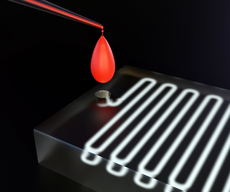Point-of-Care Blood Biomarker Analysis System
TECHNOLOGY NUMBER: 2019-118

OVERVIEW
Microchip device that measures biomarkers present during sepsis- Transmits data to a smartphone machine learning algorithms to direct care
- Shows promise for other systemic illnesses such as asthma and inflammatory diseases
BACKGROUND
Sepsis is a systemic inflammatory response to infection that affects over 750,000 people in the United States each year and leads to 250,000 deaths. Sepsis can lead to organ failure, though its onset may be difficult to diagnose due to the heterogeneity of the disease coupled with lengthy delays in obtaining results of blood cultures. The wait for an accurate diagnosis of sepsis may therefore take days, though timely delivery of treatment is essential to prevent rapid progression of the inflammation into septic shock. The identification of serum biomarkers might provide a means by which to provide early detection, prompt intervention, and progression monitoring of sepsis. While point-of-care solutions have shortened diagnostic times to 1 hour, those approaches are limited in their ability to integrate with clinical workflow, manufacturability, and robustness. As such, a need exists for improved methods to measure biomarkers which herald the onset of sepsis and assess treatment response.
INNOVATION
Researchers have developed a microchip device called the Smart Pipette that successfully analyzes blood serum for several biomarkers present during sepsis. The device incorporates structurally engineered gold nanoparticle biosensor arrays and atomically thin photoconductive nanosheet channels into a compact module architecture. The disposable system tests blood samples for four cytokines, including procalcitonin and interleukins IL-1b, IL-6, and IL-10. The recovered data is readily transmitted to a smartphone where machine learning algorithms provide insight on disease severity and potential treatment practices. This rapid point of care system provides results within 30 minutes, negating the potentially deleterious effects of waiting for blood culture results before initiating therapy. It may be utilized in intensive care units or even by first responders assessing patients who have become ill in a home or nursing home setting. While designed for sepsis, this technology shows promise in detecting other systemic illnesses such as asthma and acute respiratory distress.